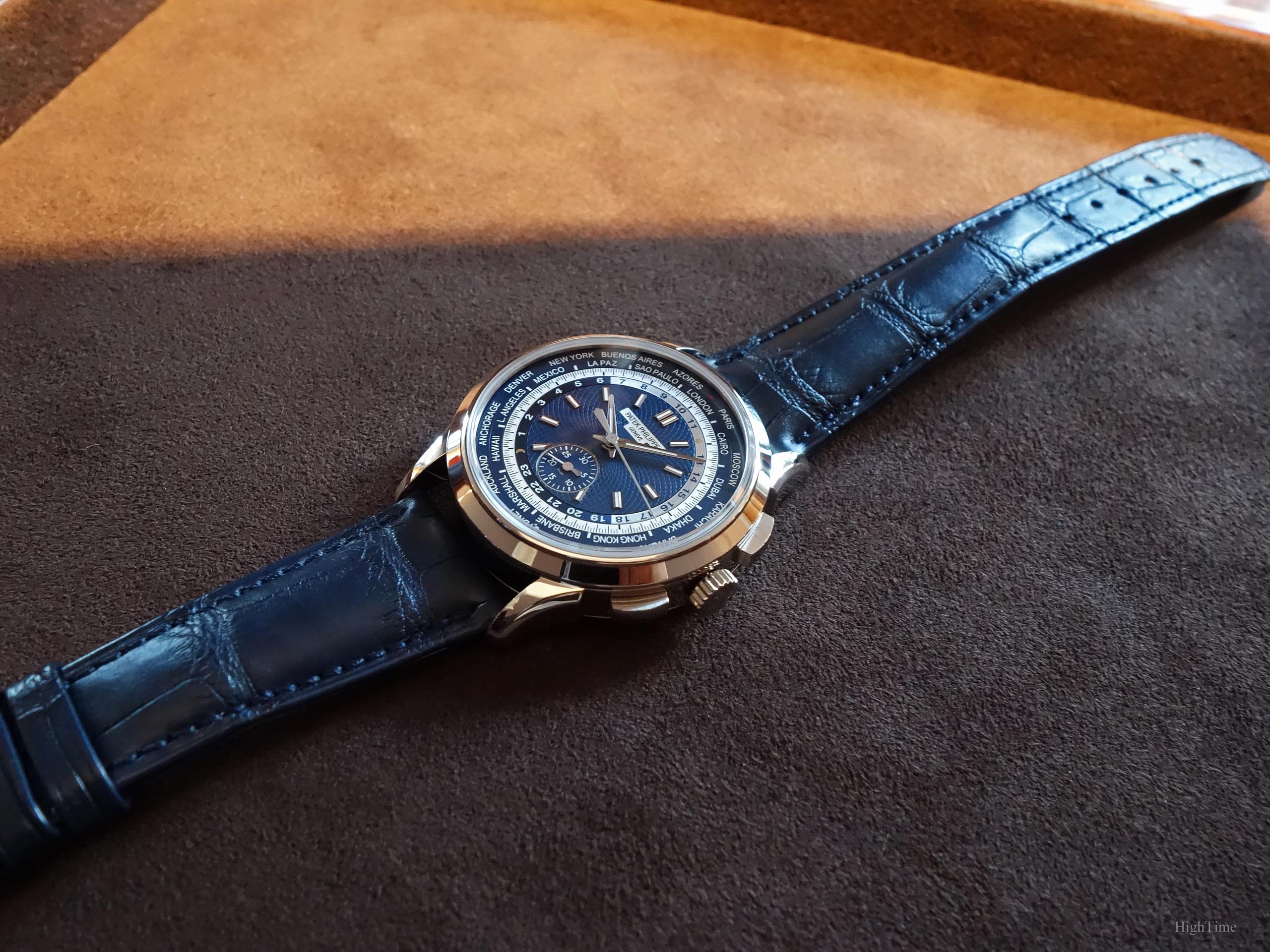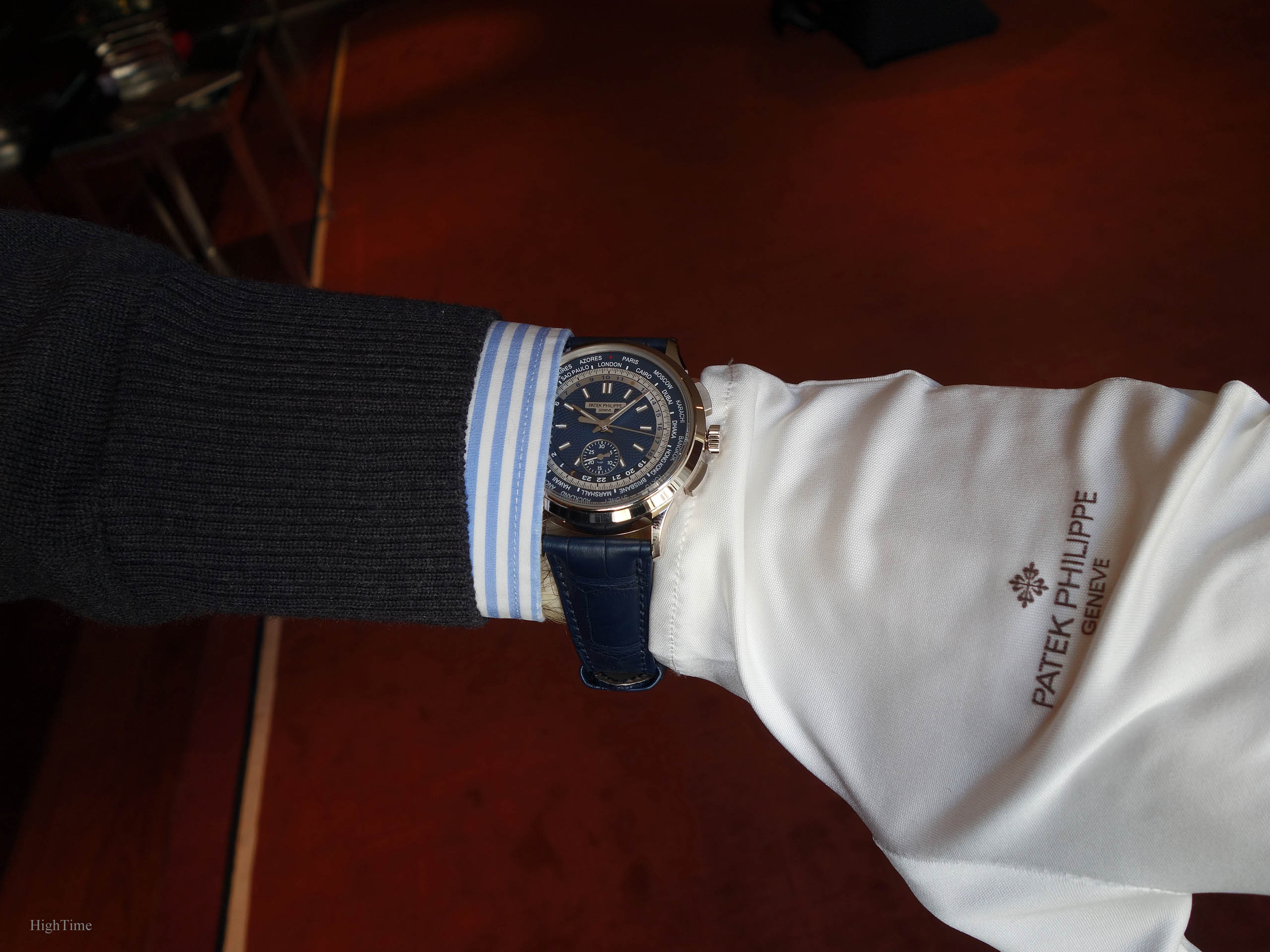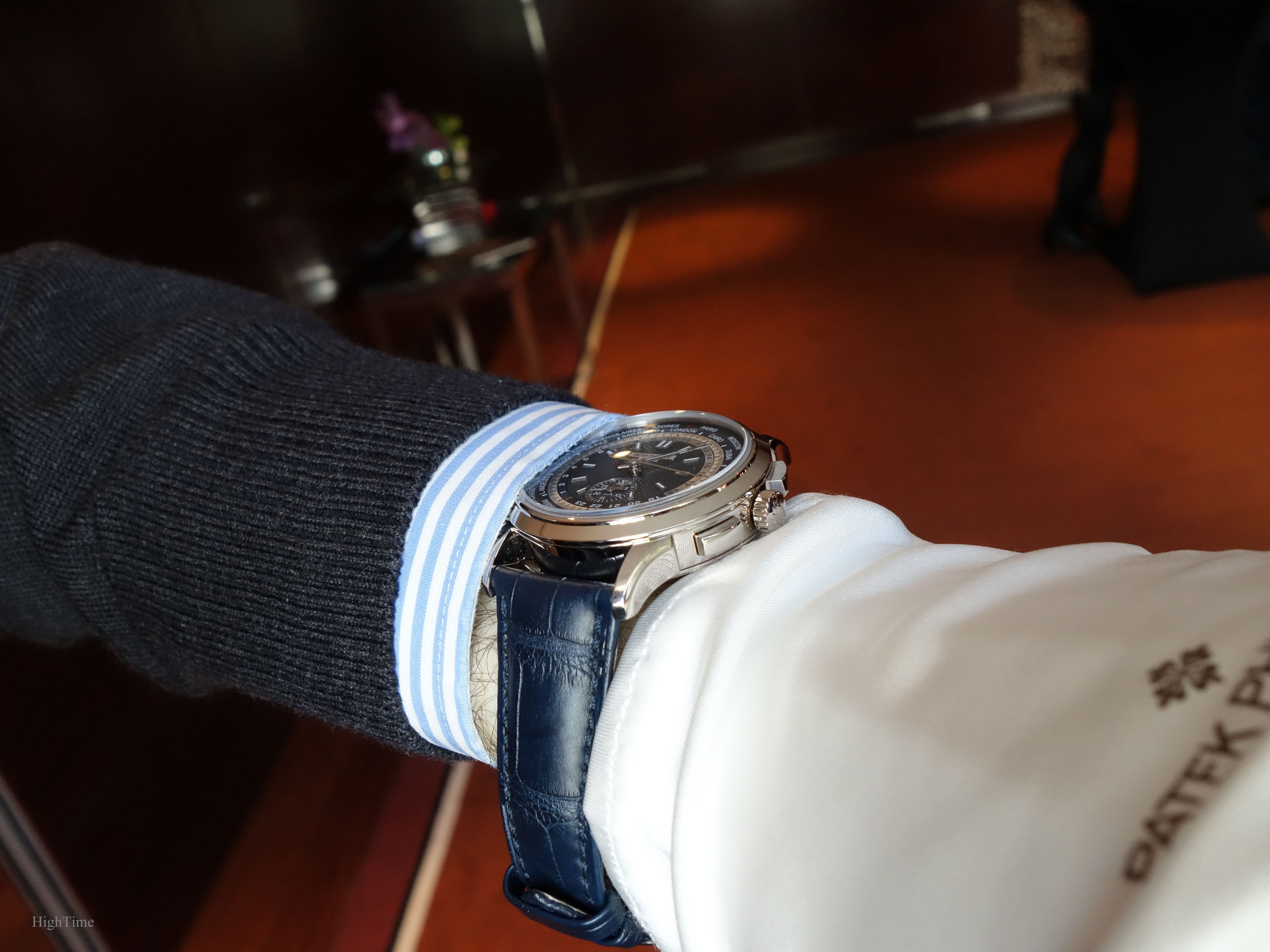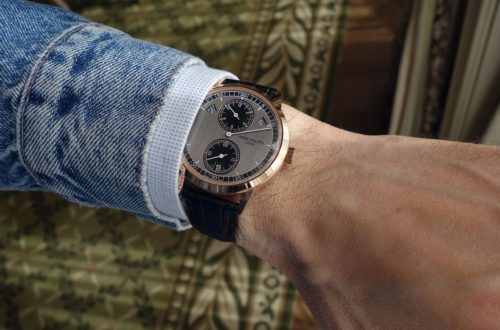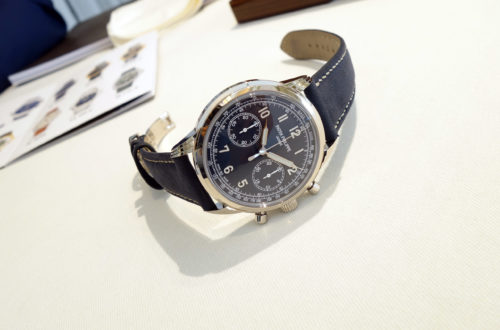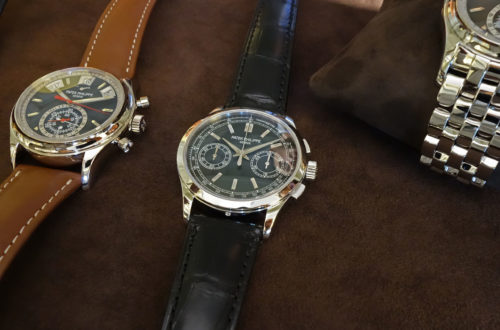The Patek Philippe 5930G World Time Chronograph – A stunning 1950’s proportions reminiscence
Hi everyone,
Back in 2016, the new model Patek Philippe 5930G World Time Chronograph was launched together with the World Time only 5230 (the 5130’s successor).
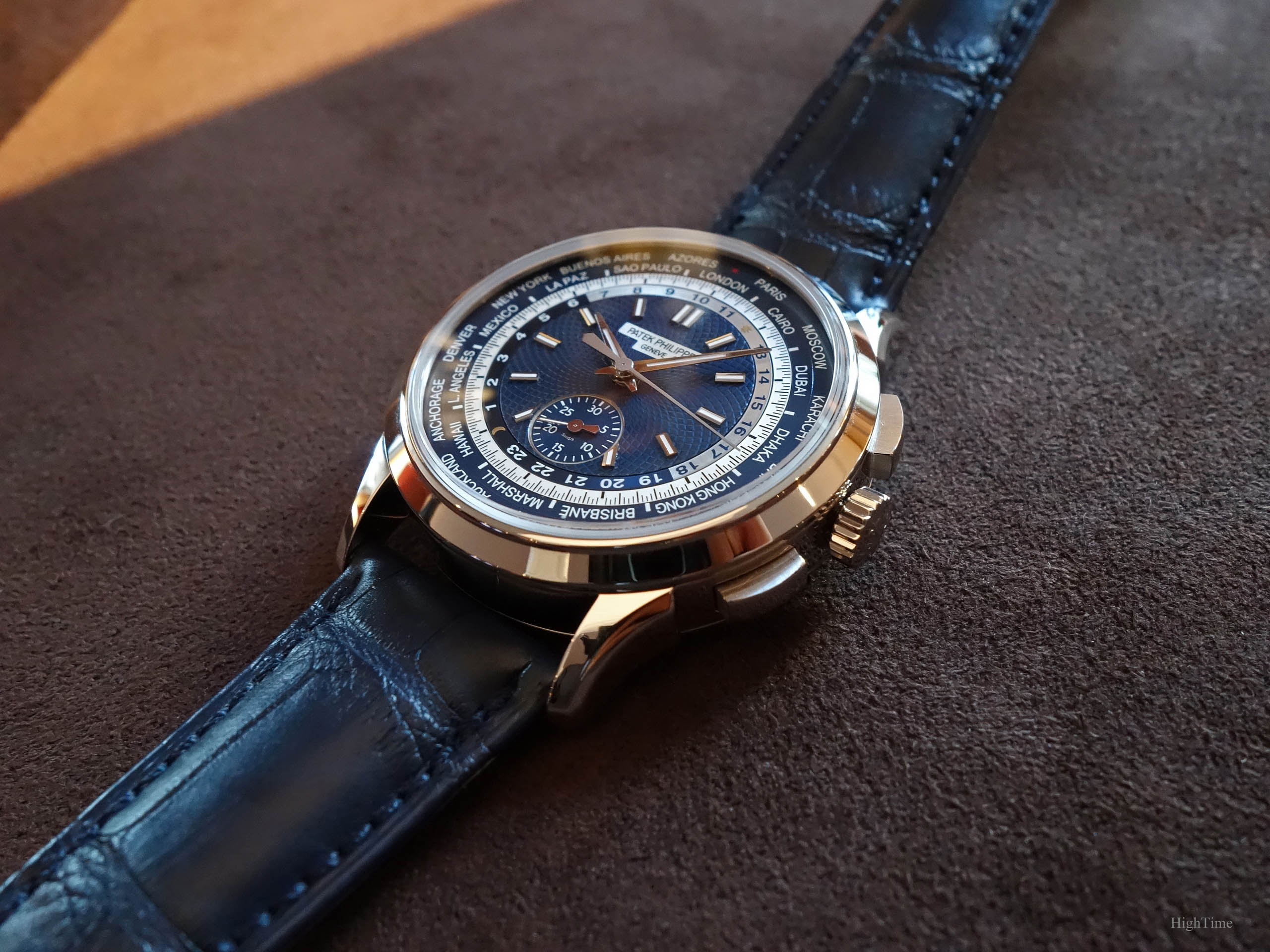
It was taking after the older and unique-made 1415-1 piece ordered in 1940 for the Doctor P. Schmidt (picture below – not the doctor, the watch). It was the first and only Patek with the World Time and Chronograph complications assembled together. The watch is now visible at the Patek Philippe Museum and remains quite famous from many catalogue covers and Patek Philippe’s documentations.
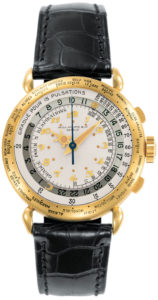
Surprisingly, this one-shot wasn’t followed by a dedicated line-up. Indeed, the 1940-1970’s era was a time when complicated watches weren’t as popular as today. And they were already very expensive. As a consequence, low production output is a part of the explanation for the high prices we see today in auctions for such vintage pieces. If you add the Quartz movements spreading on the market in the 1980’s, you’ll understand the strong demand > offer imbalance it led to.
Then, the 1990’s – which would be the early starting point of the current “glorious thirties” period for the watchmaking industry – was the time when the collections started to be reworked. This momentum provided the complications and diversity that led to the landscape we know today.
The 5930 reference finds perfectly and very naturally its place in the catalogue regarding the brand’s history. It offers the usefulness of the World Time complication that many travellers appreciate, which introduction in the Nautilus and Aquanaut lines is a clear sign of. More particularly, I’ll go through how it has cleverly been designed, technically and aesthetically.
Such a pretty face
This 5930 is not “styled” as a traditional romantic 1930’s-1940’s piece but rather as a 1950’s-1960’s and this is what makes all the difference on many levels.
To begin with the dial, the color is made of a medium metallic shade of lighter blue that makes the watch less austere and serious than with a darker dial (lapis lazuli, night blue…). The “blue” (PVD) is a little “greyish” (metallic) which gives a very appealing feel to it. This is what creates the overall symbiosis between the different steel dial parts (rings, scales…) and the blue coatings.
This is slightly different from the other Patek blue dials we know (even with sunburst ones like the 5905P’s, 5070P’s or 5200G’s). This is mainly due to the decoration of the dial base. It gives it a little more casual touch. Even more so, true to Patek’s legacy as a dial maker, it is much more appealing than combining a blue surface with silver rings, whithout trying to “link them” via a commun tone. This is a colorist work and what makes these dials stunning in the real.
I would say it fits very well the “globe trotter” spirit of a World Time complication and the casual (for work) or sportier (for everyday) way people dress today. And remember that blue isn’t new for Patek; the 5070P or the 1960’s Golden Ellipse line-up also presented a few back then already.
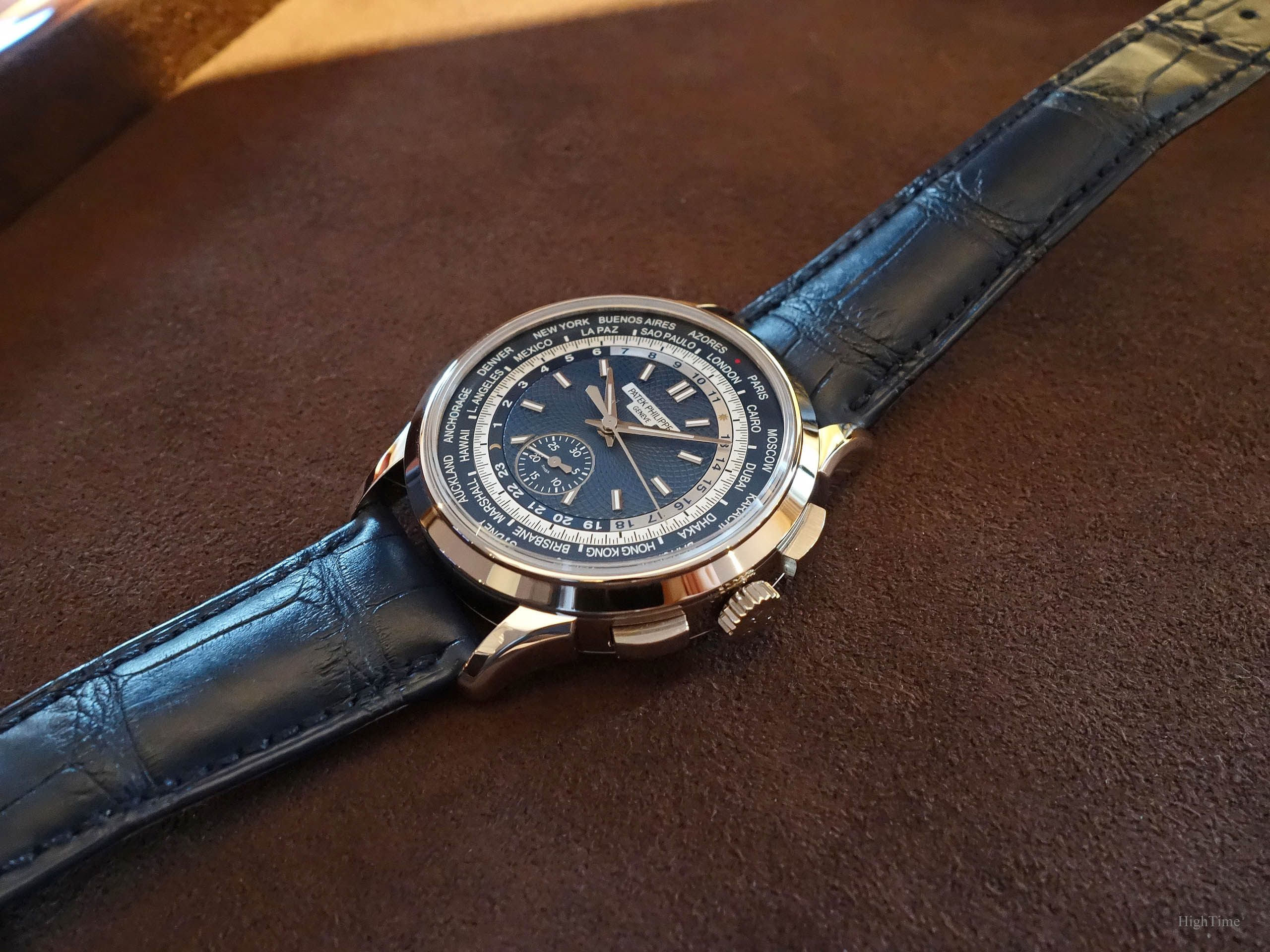
In the mean time, the addition of some white elements makes a contrasted two-tone pattern that remains very elegant. As I said in the past, I like when colors are combined with grey elements, especially when the color itself is mixed with grey, as it carries a more refined impression. This is a subtlety I like in paint, fabric or any other decoration as well.
As usual, this is something you must see in the metal to appreciate fully.
The dial has been designed to provide an optimized legibility, considering there is so much information to display regarding the 2 main functions the 5930G houses. Considering that this is a World Time model (usually busier) combined with a Chronograph function and its scales (also providing quite busy displays), I find the dial indeed quite clear to read. And generally, the more you get used to your own watch, the more natural it is to read the information you seek.
It sports a subtle manually “guilloché” decoration with applied white gold markers and a 30-minute chronograph counter. This subdial is perfectly integrated and doesn’t stand out clumsily as it can look on close-ups. Its delicate white gold ring surrounds a white minute scale and a discreet circular-grained finish. In the 1:1 “live” conditions, it shows a great balance with good proportions.
The “guilloché” decoration is something unusual (unique?) for Patek and sometimes used in rare watches. This is a mastery the respected independent watchmaker Kari Voutilainen si well-known for. It usually requires a specific lathe machine, historically manually controled.
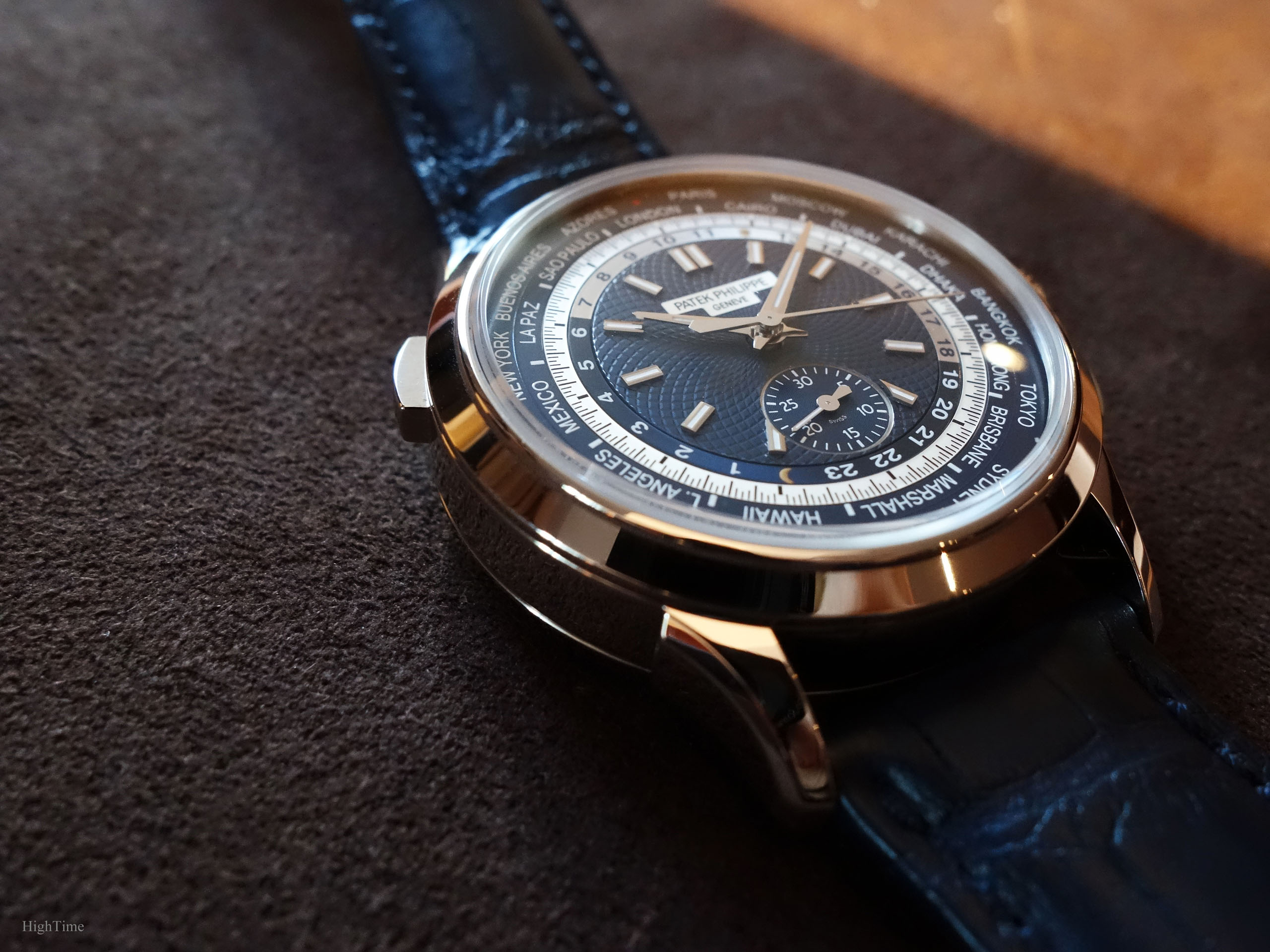
One detail I like a lot is the “Patek Philippe”-printed plaque. It is very unusual on Pateks (seen it in the 4978-400 diamond-set for ladies) and I find it very qualitative in the look. It matches very nicely with the other silvery elements (the 24h ring, the chronograph’s scale, etc…) and the overall colouring tone. I guess the main down-to-earth reason is also that you can’t print on a guilloché dial -_-
A word regarding the hands. I think that, after having seen the 5204, 5170P or 5905P, I like this peculiar “dauphine” style for such model. They are as beautifully classical but just from another era. The fact they have a line of lume inside is of course part of the impression. They wouldn’t have looked as “modern” without it; like the 5960P’s hands wouldn’t have been as good looking without lume either (and this is also true for the 5370P). I guess this has to do with the more casual look of a 5960 or 5930. Furthermore, the hands are facetted, details you don’t notice at first but that has a significant impact on the overall impression a watch leaves.
It isn’t just about adding one or two details in a classical watch. It is a whole new complete and homogeneous design. Like most of Patek watches, every detail count, and there are many that you don’t notice right away.
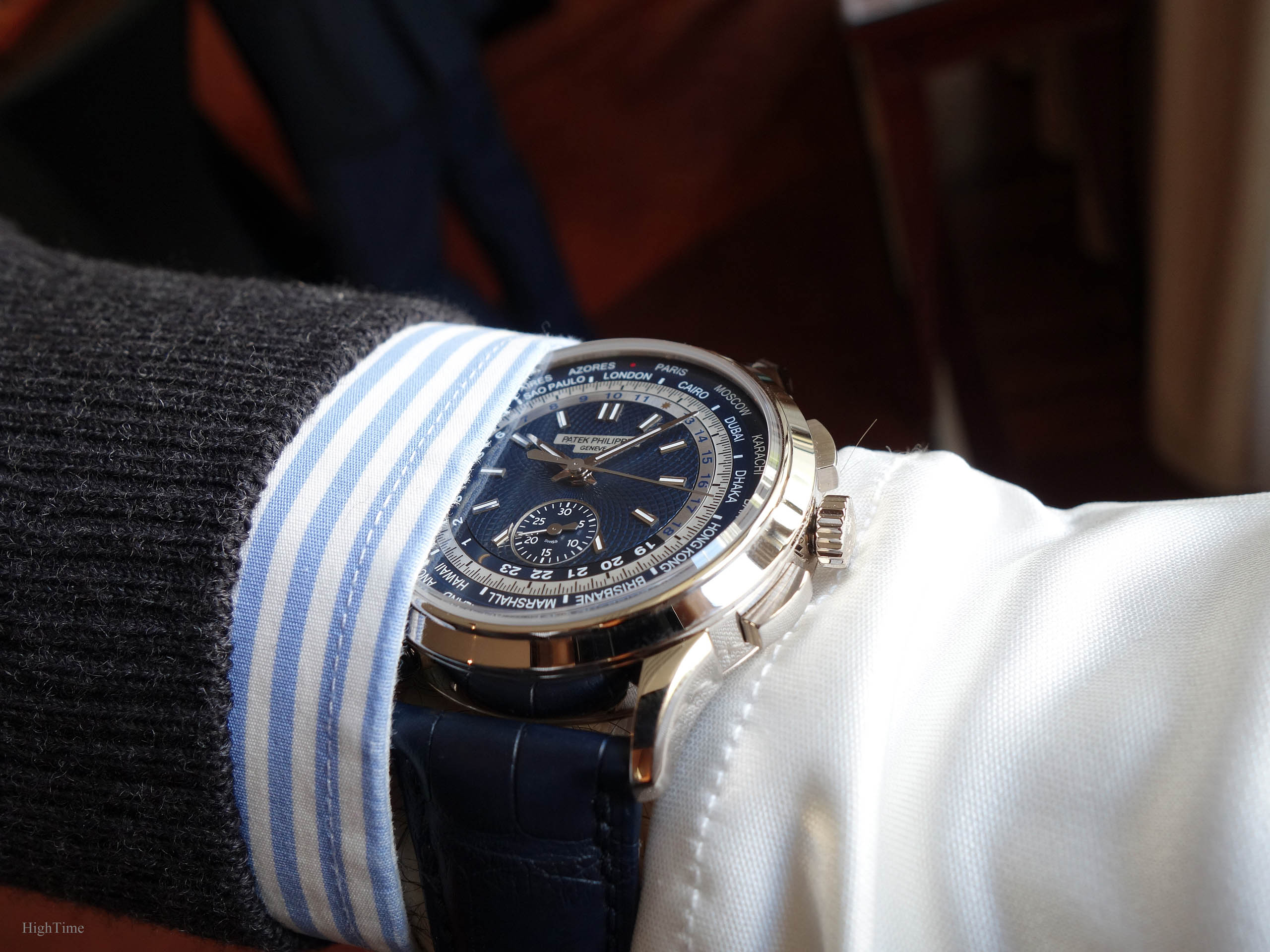
I think it is a very nice design that we will certainly see permanently in the collection with the forthcoming novelties. A limited red version was offered during the Singapore exhibition in 2019 and we recently discovered the Platinum green dial version, pictures below.
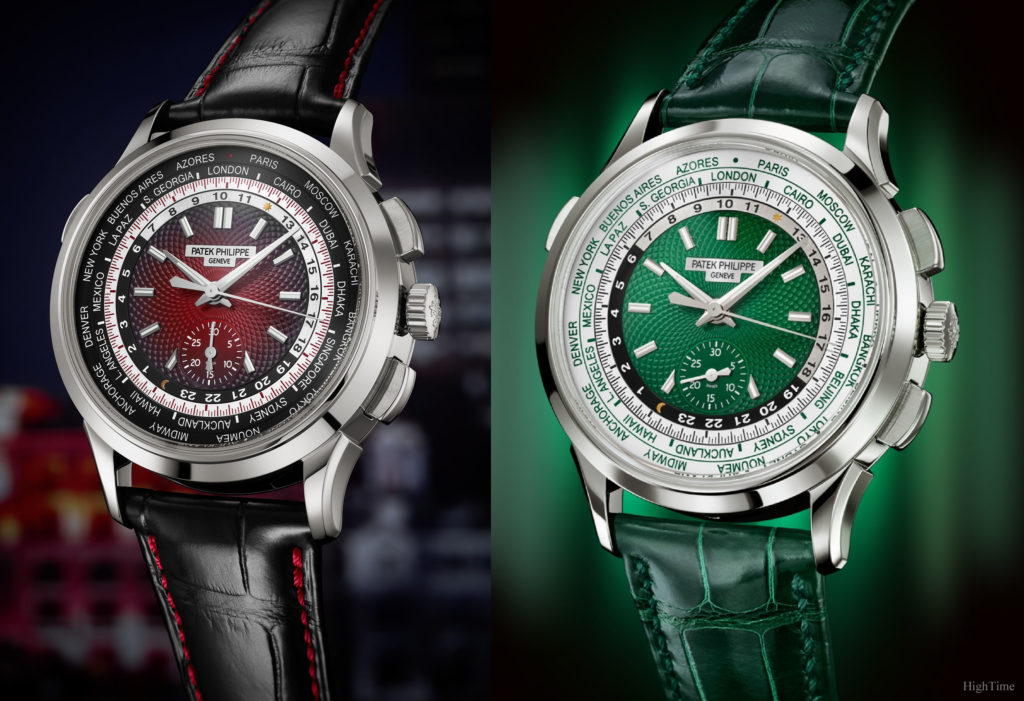
Another interesting detail I noticed: the way the 5 and 7 o’clock applied markers, next to the 30-minute counter are directed toward the center and tangent to the seconds subsidiary dial perimeter. This makes the dial well balanced and requests an additional crafting work to adjust it carefully. It would indeed have been easier, less time consuming, just cutting them in 2 squares though wouldn’t have looked as nice.
About the chronograph display
A small gap between the city disk and the 24-hour ring accommodates the scale of the chronograph seconds hand (as the Time minutes one). It is a narrow white circular scale with fourth-of-a-second graduations. This subdivision reflects the movement frequency of 4 Hz, which allows times to be stopped to an accuracy of one-eighth of a second.
The chronograph counter at 6 is a 30-minute display. I tried to think about the alternatives to this choice but, frankly, I didn’t feel satisfied with what I could think of. It is true that it may be too short for people used to the 5960‘s 60-minute + 12-hour or the 5905’s 60-minute-only indications (same 28-520 caliber base) who will use it for a flight or a long parking time lap for instance.
Well, what other choices then?
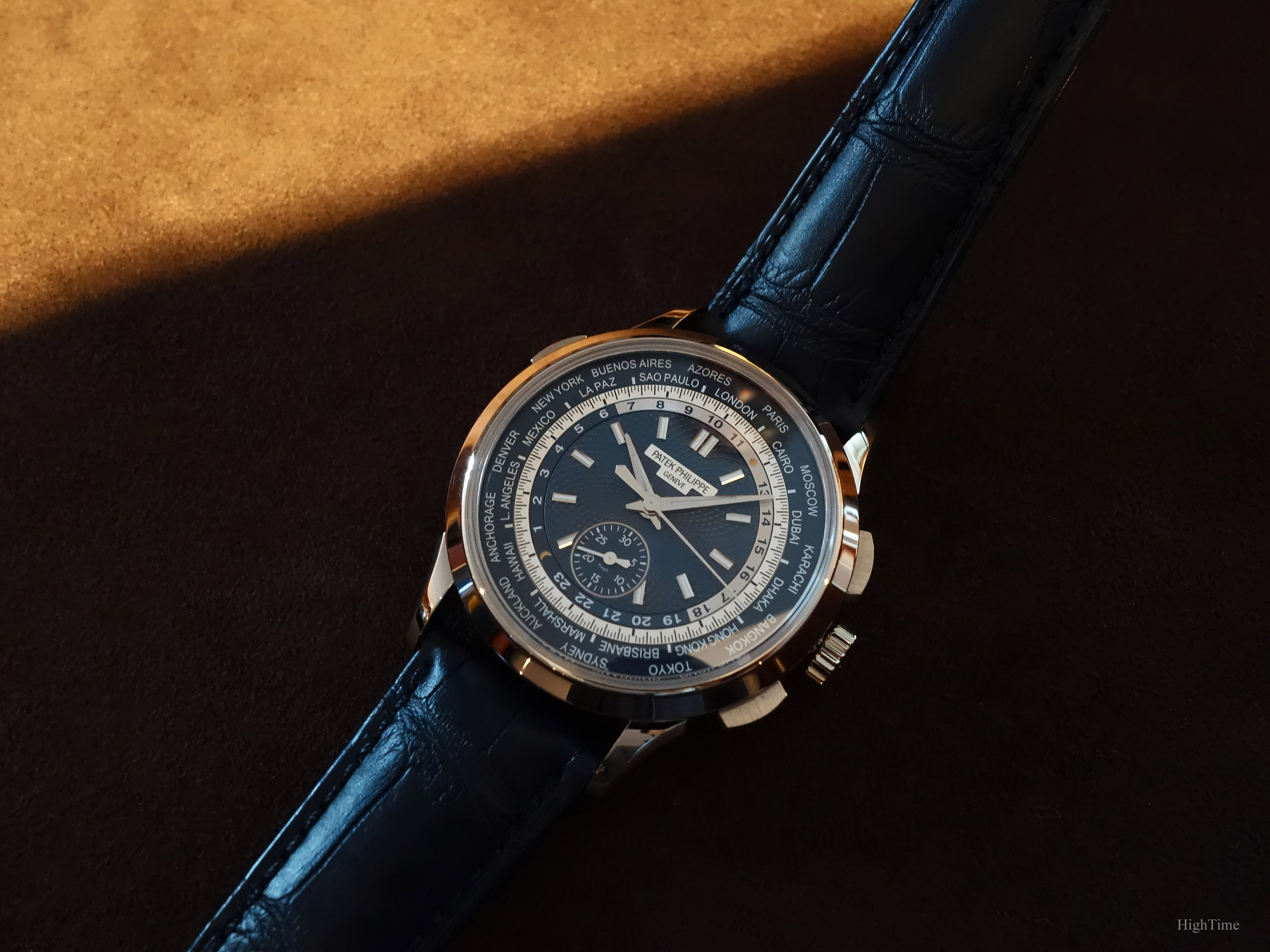
– Why can’t we have both, hour and minute hands (like in the 5960)? Well, there was obviously no room left if sizes had to remain contained.
Because indeed, as mentionned further in the article, it is due to the complexity of the dial construction (you can see the illustration further below): the 2 dial parts are designed to be the WT module mainplate itself in that reference. This is what is unique regarding usual designs and what represents a masterwork for Patek’s watchmakers.
Not many brands today look for such difficult improvement in a way to optimize a watch, while keeping things as “simple” as possible and not for unnecessary communication gimmick. This configuration was chosen in order to keep the watch as “compact” as possible. This latter issue is a major characteristic of most Patek watches. It is always easier to include movements in big cases but less appealing and less difficult to realize regarding watchmaking mastery in general.
Hence, implementing an additional hour scale to the minutes display (like in the 5960, same 28-520 caliber base) would have implied a bigger case and a very complex construction in order to place it next to the WT complication (more wheels, more pinions, thus more holes, etc…). Remember the chronograph minute counter already had to be moved to implement the World Time 24h ring.
Indeed, the Annual Calendar display in the 5960 doesn’t cross the whole dial the same way the World Time does in this 5930, hence more room under the dial.
– The problem is that a 12-hour scale wouldn’t have been precise enough. Still a 30-minute scale was more useful for most of the people still using the chronograph function.
– Then, maybe getting a 60-minute scale (like in the 5905) instead of 30 would have been a good setup? A longer time lap, remaining precise enough? My guess is that putting a 60-minute detailed scale (1 second = 1 mark) in the 5930’s tiny subdial wouldn’t have been legible.
In the end, people will see what information they need but remember that manual chronographs like the 5170 or the 5070 have a 30-minute scale as well. I guess some of us have been used to having the fantastic 5960’s layout and that we are always being more demanding when it concerns Patek Philippe. However, this 5930’s chronograph function doesn’t provide less information in the end than a manual chronograph, together with the time around the world.
Around the world, around the wo-orld
Approaching the World Time function, this dial gathers an intricate succession of mobile and fixed parts: the city ring, the 24h ring, the dial…. This is hard to cope with when designing the mechanism, making all information available on the same dial while keeping it legible.
It is a nice and complex show to enjoy watching while setting the timezones with the unique 10 o’clock pusher. Another good thing is that the mechanism has been used and mastered since quite a while now by the brand.
It had been updated back then with new cities (still 24 cities displayed) for some time zones. For instance Dubai instead of Riyadh or Brisbane instead of Nouméa. It also took into account the fact that Moscow changed its local time from UTC+4 to UTC+3.
For your information, there are, as far as I know, at least 2 versions:
- The first 5930G-001 (from 2016), with Hong Kong;
- The (current in late 2021) 5930G-010 with Beijing replacing Hong-Kong (like the 5930P-001).
Again another case beauty
The case is often my favorite part and the 5930’s is one of the 2016 collection novelties: a style inspired from flatter surfaces and sharper edges instead of rounder and curved ones from more traditional references.
The 5930’s is provided with wonderful “smoother” and traditional lugs (an evolution from the 5970/5270). Patek Philippe opted for this same style pattern in the 5230 World Time launched at the same moment. In such a technical looking dial, this case brings the touch of elegance it requires to be worthy of the brand. I find them also more exciting than the lugs we find in more classical pieces (like the 5X96 line-up for instance), though they don’t have the same goal.
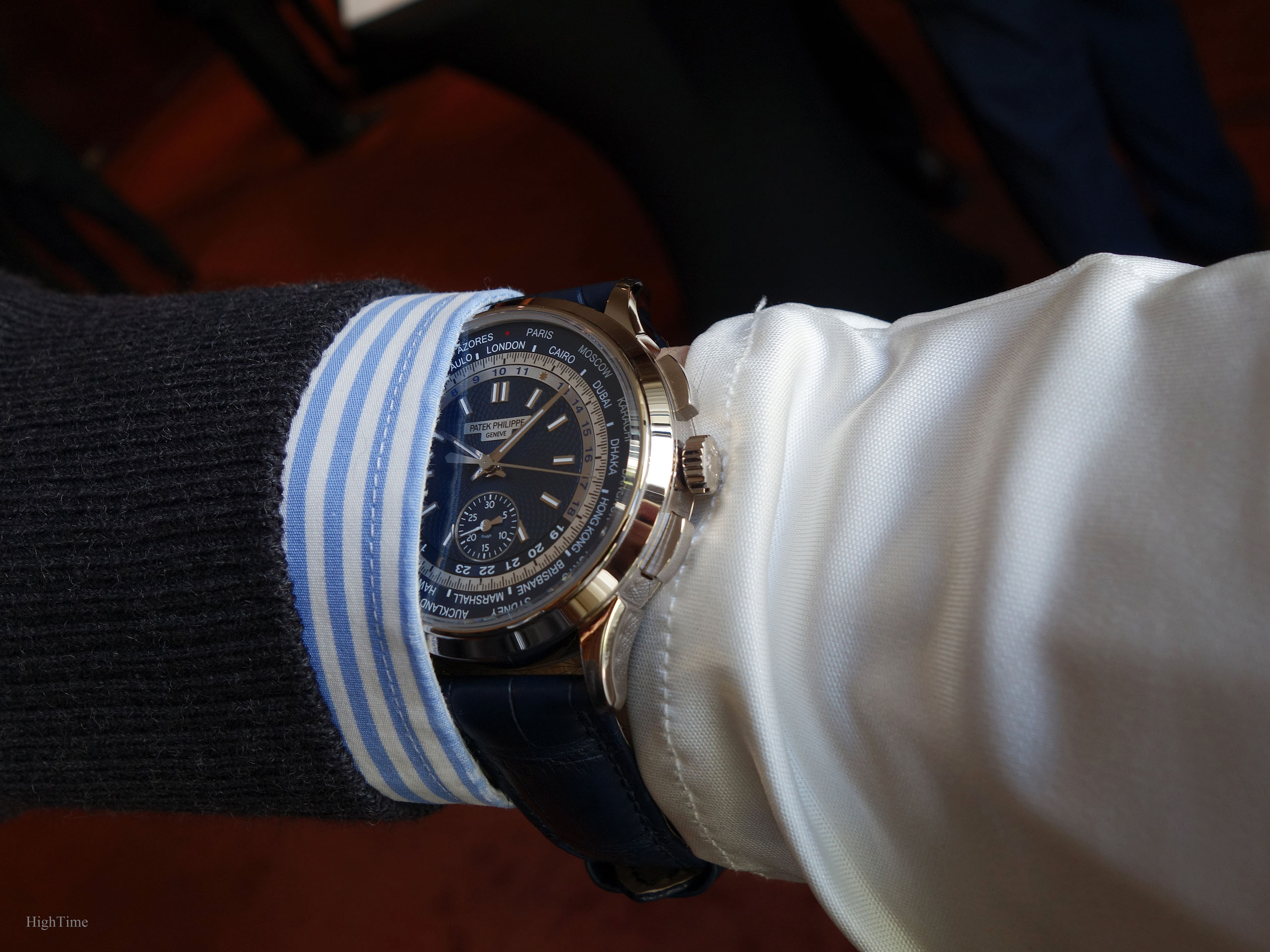
The 30m water-resistant 5930 reference is 39.5 x 12.8mm (as a comparison, the WT-only 5230 is 38.5 x 10.2mm) which is certainly one of the thinnest out there (as another comparison, a Vacheron Heures du Monde, with WT-only, is 42.5 x 11.6mm). What is really interesting is that the brand decided to maintain the watch below 40mm while the watch looks a little more casual and is quite complicated (thus has to have a minimum thickness). Indeed, more complicated watches with a casual/sporty look are usually on the “bigger” side of the spectrum.
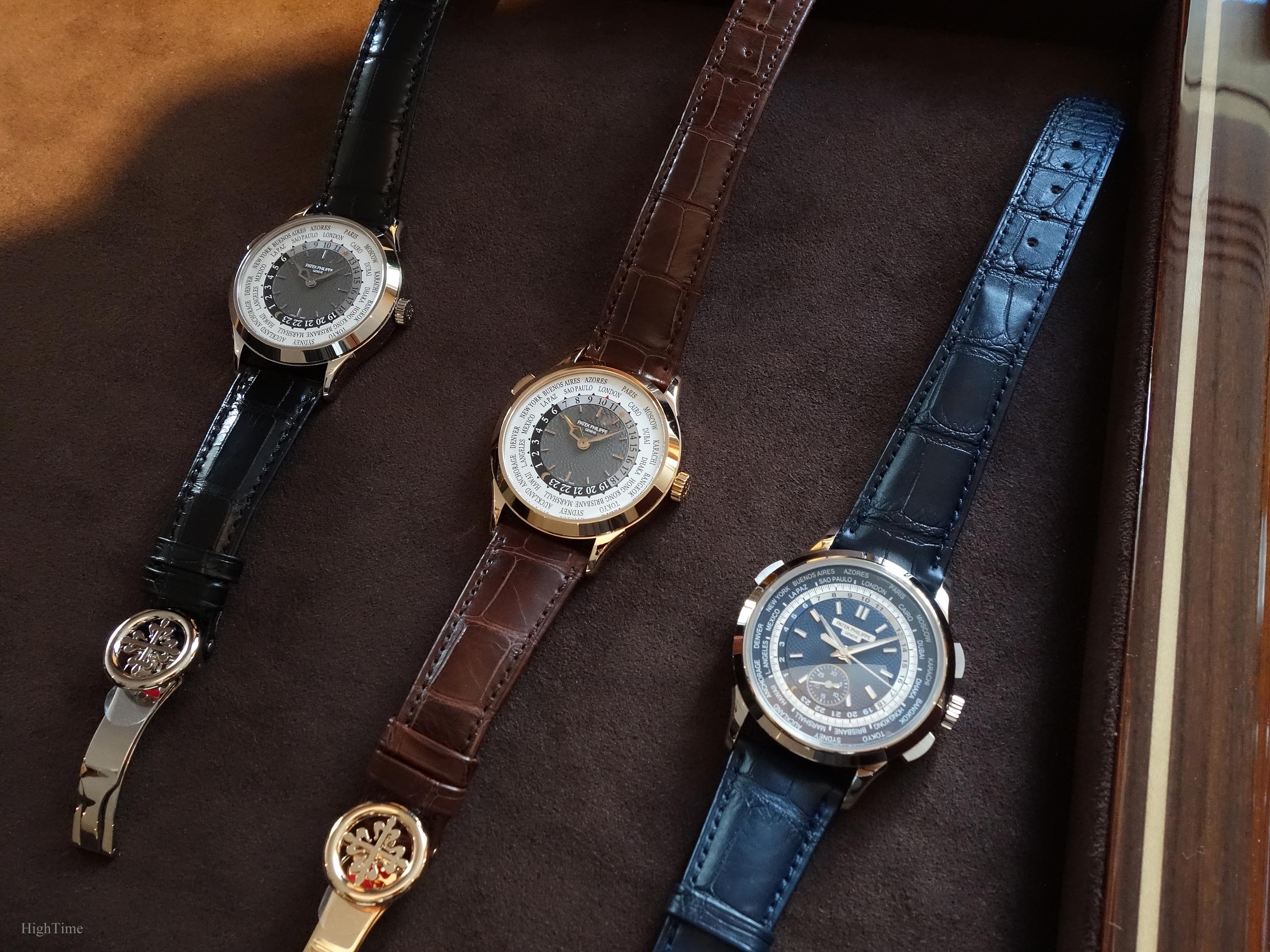
Smaller watches (not too small though) always feel a little more traditional and this is a feature I appreciate. As a comparison, the 5960 model, housing a 28-520 base as well (and an Annual Calendar instead of the World Time module), is 40.5 x 13.55mm. Moreover, the more angular 5930 amplifies this impression.
Relatively, the 5930’s dimensions show two things:
- It was a firm stance on the aesthetical orientation to get these singular proportions;
- The challenge it represented in order to maintain its size at the minimum possible level, considering what it offers movement-wise. It’s an area Patek puts a lot of effort in, visible throughout their whole range, e.g. the 5204, 5327 or other grand complications (triple grandes complications, Minute-Repeaters, Tourbillons, etc…).
From my hands-on experience, I must say I enjoyed very much this 5930’s unusual case proportions: it has definitely a slightly different balance, a little smaller width together with a higher tickness from what we are used to seeing nowadays.
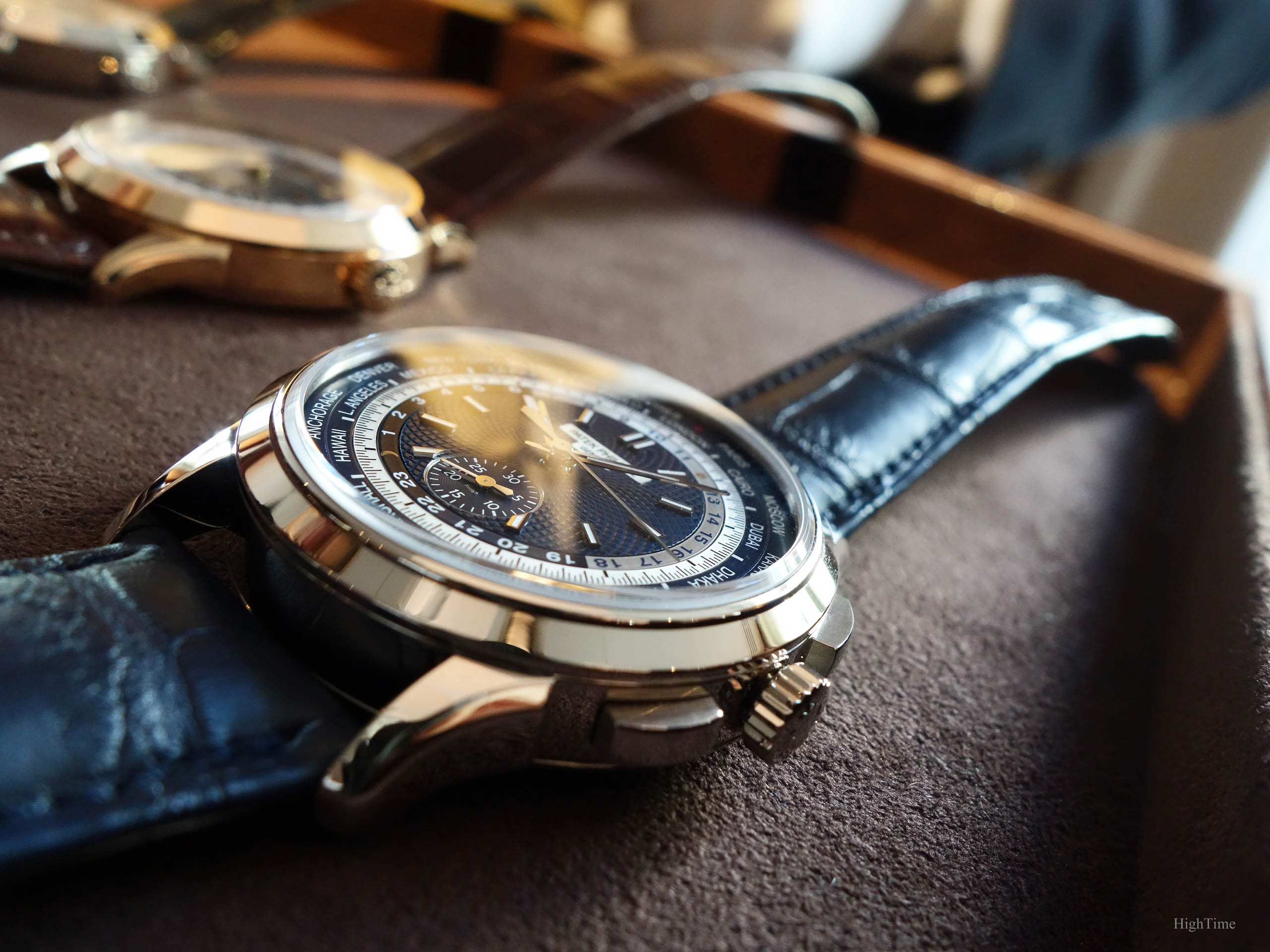
Indeed, it reminds me of complicated models we know from the 1950’s-1960’s. At that time, it was a very recognizable signature from complicated watches that measured around 33 to 36mm. The 5959 Split-second was 33mm (!) and discontinued a few years ago. I remember seeing pieces from that time that were quite thick and more complicated but which remained in smaller case sizes (which was the standard at that time). We are used to calling them affectionately “hamburgers” today. The 3970 for instance shows this same kind of proportions, bringing an authentic and vintage feeling that I really enjoy in the 5930 today.
Watches were small in diameter but still thick, hence a very different overall aspect, sign of complicated calibers. It is related to the older period and older aesthetical standards that are references of a great creative period.
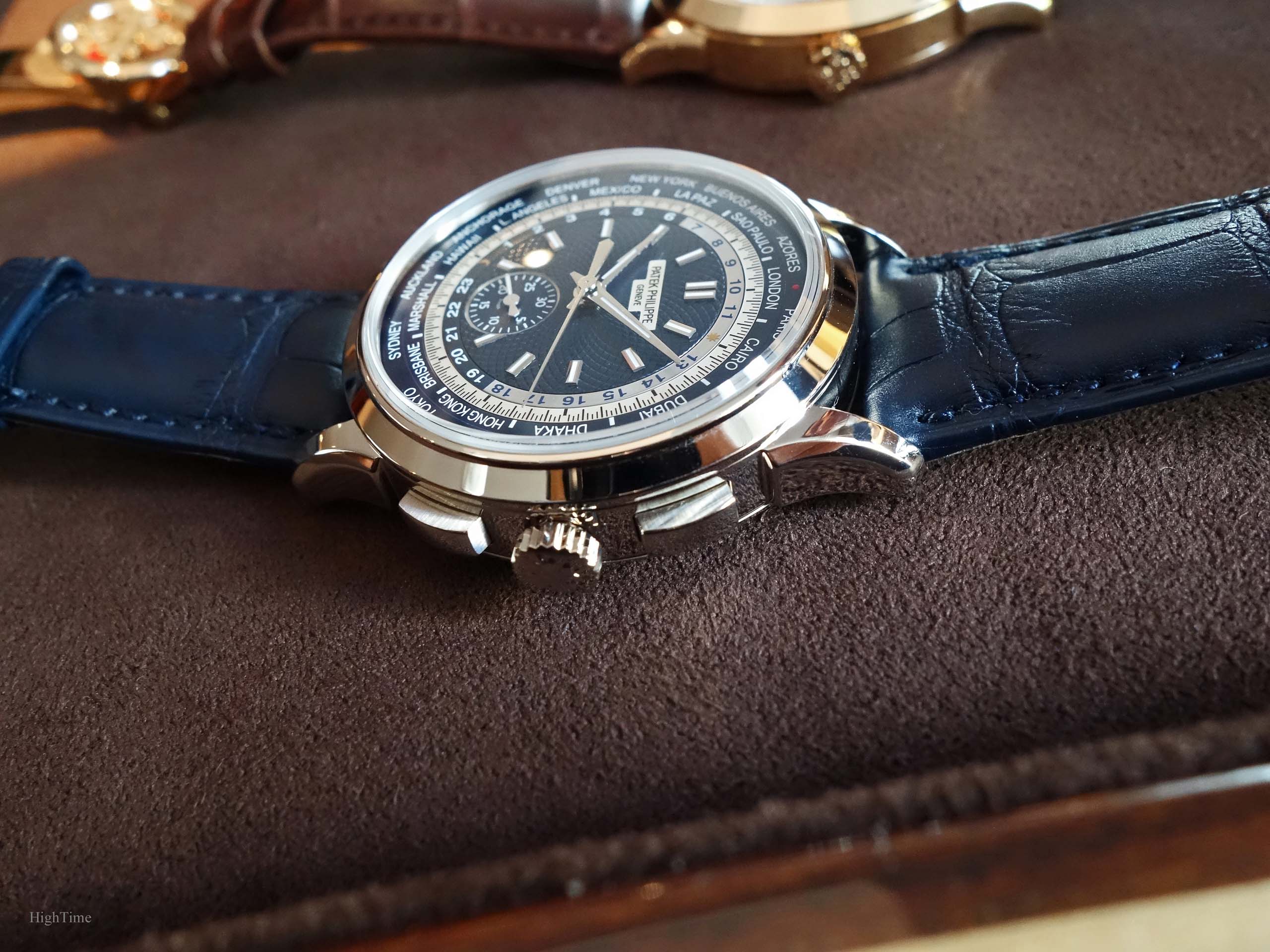
Of course (and hopefully), it is 39.5mm this time (and not 34 or 36) which places the reference in today’s standards. I think best of both worlds if one is seduced by that. This is a move from Patek I find very interesting and that I wouldn’t have thought of for a current collection. For someone who enjoys below-40mm cases, this watch looks stunning.
In the metal, I could confirm this caseband is gorgeous and that the lugs count for a huge part in this feeling.
On the bezel’s side, the top side is much more inclined compared to the usual 5296/5396/5496 ones, or the 5170‘s (similar style), like a reminder of the “Volcano” 3448’s style. It visually helps downsizing the caseband height.
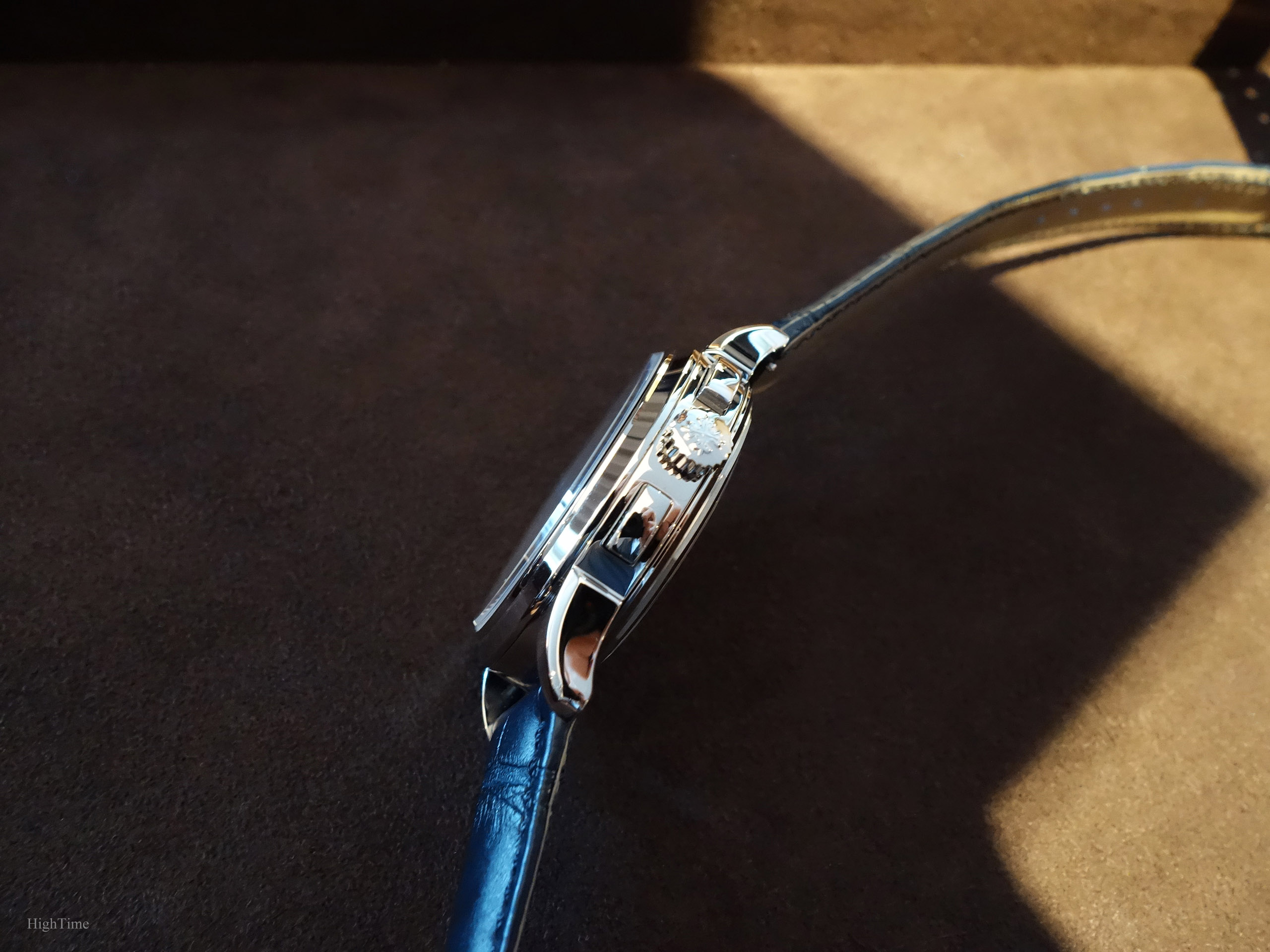
Finally, it is mounted on a hand-stitched matt navy blue alligator strap with large square scales to match the dial, equipped with a white gold fold-over clasp.
This outstanding movement
As I said above, keeping thickness as it is was challenging considering the Chronograph and World Time complications the 5930 embeds. The evolution on the CH28-520 base caliber is a work of art that I’ll detail further and makes this reference so interesting to consider.
Its 28.800 vph rate allows a more consistent balance wheel amplitude during the day.
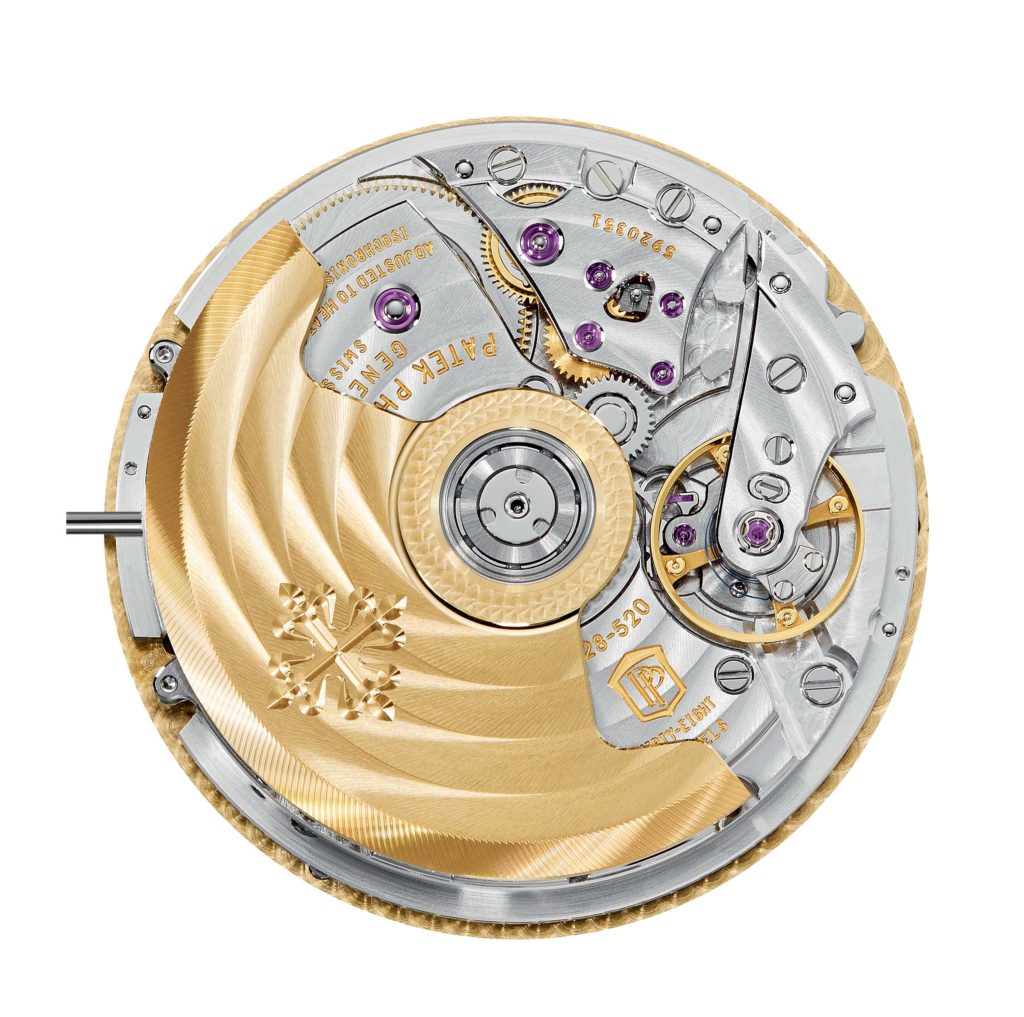
Something we learn about the construction’s uniqueness (in the video with Mr. Philip Barat, Director of Development, linked at the end of this article) is that, in order to gain space and reduce the thickness of the movement, the aesthetical parts (dial) are merged with the movement elements. A true interesting detail about the fact Patek uses room in the watch as efficiently as possible. A proof that watchmakers can improve or bring evolutions in traditional watchmaking without betraying their brand’s legacy.
It tells more about today’s habits in watch development. Indeed, with cases going bigger and bigger (for aesthetical/cultural reasons), it becomes easier to remain “lazy” about keeping movement sizes tight. Yet, this is a problem because dealing with limited room is one of the typical challenges watchmakers face when designing a model.
It is always harder to compile mechanics in a smaller space and even more interesting of a challenge when it remains wearable.
We can appreciate the work done by Patek for the 5930G, especially in terms of wearability and comfort compared to other offers, even more so when considering the fact it provides a vertical clutch Flyback Chronograph as well.
Back to the movement, the biggest difference from its ancestor is that both the World Time and the Chronograph Flyback complications have significantly evolved since 1940, as you can imagine. Thus, the combination of both is a totally different mechanism from its old predecessor.
The movement used as a base is the 28-520 caliber, the same embeded in the 5960 (for the first time in 2006) and 5905 families. This being said, the Chronograph and the World Time mechanisms were enhanced with extensive modifications in order to move the chronograph’s minute counter to include the WT cities and 24h/Day-Night rings. You certainly can imagine how tricky it is to correlate the different rings moving on the dial side with the mechanical elements linked to the time and the chronograph that lie beneath.
To understand what it represents (next picture further below), this leads to a mere 7.97 x 33mm caliber size. The WT module itself is 3mm thick while the Chronograph+base functions is 4.9mm (as a comparision, the Vacheron Overseas WT-only caliber is 7.6 x 36.6mm). Amazing.
In the end, they have a young and already very well designed movement that they nevertheless decided to modify heavily for this new reference. If this isn’t pure dedication…
As Patek says, axes were shifted, bridges thinned and newly designed, and component clearances changed, so much so that the caliber CH 28-520 HU can legitimately be called a new movement. It embodies everything that belongs to Patek Philippe’s proud watchmaking know-how.
(you can have a look at the modules in the video, also posted at the end of the article, from the 5:10 mark)
Moreover, it is very easy to understand and to use, which is a sign of good design.
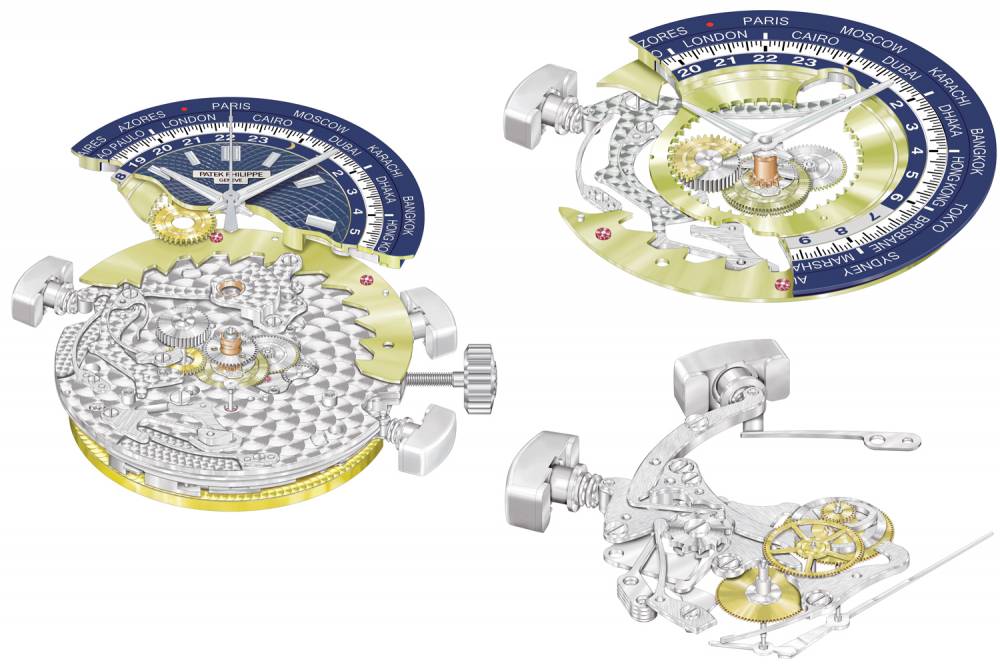
Regarding the Chronograph function
Let me add something I mentionned in the 5960G review already (28-520 based as well). This first “in-house” automatic chronograph caliber for Patek (in the 2006 grey dial 5960P-01):
- is “Flyback” (hence can be reset without being stopped first);
- has a column-wheel feature (many vertical clutch chronographs don’t, as they are activated with cams) that provides a smoother activation feel;
- and, thanks to the vertical-clutch design,
- gets rid of the little “hand-jump” during the start (when the 2 wheels mesh together);
- brings impovement in terms of wear: the two disks stick to one another instead of teeth “colliding” together while running;
- brings improvement regarding energy loss: less amplitude loss compared to a classic horizontally coupled chronograph.
This is why Patek claims the chrono function can also be used as a permanently running seconds hand without risking undue wear and without affecting too much the rate accuracy or the power reserve of the watch.
Indeed, it is usually not recommended (especially for horizontal-clutch ones) because of the additional wear and the decrease on the balance wheel’s amplitude. Here, with this 28-520 caliber, the wear and the amplitude loss are very low, due to the design. This is a great advantage. Furthermore, since it is a self-winding movement, the torque will remain high during the day.
On a theoretical standpoint, it could be analysed as such (nerd alert):
- Despite it should be (close to) irrelevant in the case of an automatic movement (remaining fully-wound most of the wearing time), I understand (I’m not a watchmaker) that it doesn’t reduce the Power Reserve. It is indeed a fixed number of turns based on the mainspring’s length and gear train size. However, the working length should nonetheless decrease, at least a little bit, when reaching the end of the power reserve. Indeed, the load on the gears is increased when the chronograph is coupled (more parts, more energy needed). Hence, the watch stops sooner (the torque is too low). For that matter, when the watch runs out of energy, stoping the chronograph should restart the time;
- While the chronograph is coupled, the balance wheel’s amplitude should decrease, thus I imagine the tic-toc rythm is increased, hence the time is “accelerating”. Furthermore, it would have theoretically led to stopping sooner if it had not been an automatic caliber. However, due to the higher torque (self-wound) and the low drag, this phenomenon seems to be negligeable.
As I said previously, I find pleasure in analyzing the phenomena appearing in such mechanics.
The caliber is equipped with the Gyromax balance and patented Spiromax balance spring in Silinvar (silicon-based material) visible through the Sapphire-crystal caseback. It is a way for Patek, since the first Advanced Research references, to bring innovation in a useful way (timekeeping accuracy, oil ageing issues, amagnetic, etc…) without neglecting the essence of traditional watchmaking.
Conclusion and Thoughts
The Patek Philippe 5930G is a true novelty that typically grew on me. Because of its uniqueness (complications, size, mainplate, look vs other Pateks), the engineering process (mainplate/dial construction development) and because I find it very attractive in the real.
How many times in the past has Patek found to be right launching non-consensual models? Many, even though often recognized later down the road only. Of course, how it will behave on the market is hard to tell.
Although the brand has kept a traditional and quite conservative image in some ways, it is definitely looking forward. Sometimes these moves are difficult to understand (like the Nautilus in 1976, the first Advanced Research, the 5070 or the first 5960P to mention a few) and of course mistakes may also happen, this is natural.
But I’ve always ended being disappointed on the long run by too conservative brands (whatever the field), if they didn’t disappear meanwhile.
This effort to progress is totally what Patek Philippe has been doing in the past, especially when considering the caliber’s engineering; finding new technical solutions that are time and budget consuming, to optimize space and functions, etc…. This is long term views, part of their DNA and also why people are very demanding when it comes to Patek watches (Minute-repeaters, annual calendar, Spiromax, new 29-535 clever yet simple improvements, etc…).
The brand has to look forward, that is to say they have to create new models while keeping them unique, elegant and timeless. “Traditional” doesn’t mean selling the same watches on and on. This has always been a job performed in order to escort the evolution of times and the will of future customers.
More than anticipating, following, it is about shaping the next generation’s tastes. One must read into the world trends and transformations in order to provide not what people want, but to seduce and to influence what people will want. From the top and not from an average and mediocre position. There are risks in doing so but it is mostly rewarding when done by talented people though not always understood at first.
This 5230/5930 new style is another family added to the catalogue and a very appealing one imho. I guess that many customers won’t see all what the watch gives (movement) but it brings modernity with classicism in the right proportions, especially in a period when the market has a strong appetite for casual/sporty models. It’s beautiful, provides this elegant and luxurious but discreet scent that we seek.
I love it (I should make a stamp).
You’ll find the very interesting 5930G video of Mr Barat, Head of Watch Development at Patek Philippe, here (and it’s interesting for whoever is interested by Patek):
The 5930G explained in details by Mr Barat on Patek’s YouTube channel
The G version was discontinued in 2022. In late 2021, pricing of the 5930G was 69 000 € (incl. VAT). Yet, you can still find the platinum version details here:
Thank you for reading!


